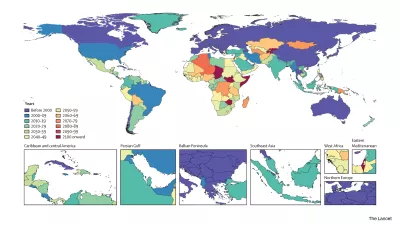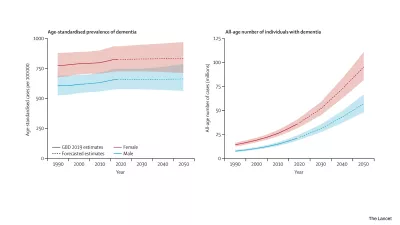Health forecasting
We create forecasts and custom future scenarios to study the impact of new policies, technologies, or interventions on health outcomes.
Key findings
The forecasting team at IHME works across multiple health topic areas, answering questions that range from “How many COVID-19 cases will occur next month?” to “What will be the average life expectancy in 2050?”
By 2100, fertility rates will not be high enough to sustain population growth over time in 97% of countries and territories.
Researchers anticipate a massive shifting of births from high-income countries to low-income countries. Unless countries facilitate ethical immigration, populations are expected to contract in areas where fertility is below 2.1 children per person who could give birth.
The world’s population is expected to peak in 2064 as fertility declines.
We will see large disparities in demographic shifts between countries. In sub-Saharan Africa, fertility rates will remain higher for longer (though still declining overall), resulting in triple the population by 2100. In contrast, the population of some countries, like Japan and Italy, will shrink to 50% of their current size.

Global dementia cases are set to triple by 2050.
Population growth and aging are the primary factors in the expected increase in dementia.
While we project that improvements in education will help reduce cases, it will not be enough to counter the effects of obesity, high blood sugar, and smoking, which are expected to increase in the coming decade.

Population forecasting

How is health forecasting work done?
Our Future Health Scenarios (FHS) team forecasts the global burden of disease, using GBD estimates of more than 370 diseases and injuries, more than 80 risk factors, sociodemographic indicators, and other drivers of health.
- The work is built on a robust framework that links drivers of health to health outcomes.
- It is a significant improvement from past work on forecasting which provided an incomplete view of future disease burden.
Understanding drivers of health and potential trajectories going forward is critical to guiding long-term investments and implementing effective policies. Knowing what might happen years or even decades ahead can provide decision-makers with the information they need to plan for the future.
Custom scenarios can answer different types of questions, such as:
- What is the impact of improved diets on non-communicable disease burden?
- What effect do fertility and education trajectories have on population size?
- How will changes in carbon emissions impact temperature-attributable disease burden?
With these data in hand, health systems and health care workers can be equipped to meet the needs of tomorrow.
- The first part of this novel framework was published in 2018 (Foreman et al. 2018).
- In 2020, the framework was used to forecast population size, fertility, mortality, and migration for 195 countries to 2100 (Vollset et al. 2020). A population visualization tool accompanied the publication.
- Ongoing work extends the 2018 paper to the full suite of disease burden measures, including incidence, prevalence, years lived with disability (YLDs), and disability-adjusted life years (DALYs), and an improved framework for custom scenarios and avoidable future burden.
More forecasting work
Our forecasting methods are tailored to each health topic that we study. Learn more about our work in these other health focus areas.



